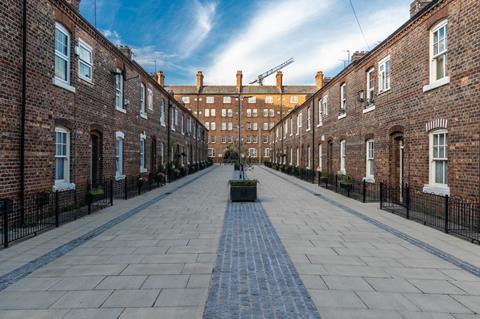With the potential to offer a strong sense of community and efficient use of land, these traditional typologies are often attractive to residents and developers, writes Matt Bowker

Building new housing at higher densities is increasingly being seen as part of the solution to balance the high demand for homes with the acute shortage of land in urban centres.
In recent years, apartments have been the preferred choice to deliver more homes in town and city centres. However, not everyone wants to live in an apartment. There is a growing demand for homes that give people personal space, control of their immediate environment, and access to private gardens, all in a central location close to places of employment, schools, local shops, amenities, and public transport.
Because of this, the terraced and back-to-back home is becoming popular again as a type of high-density housing that works well for delivering new homes in town and city centres.
The terraced house is an enduring and popular house type with shared walls to either side, whilst the back-to-back is a form of terraced house with an additional shared wall to the rear.
Both offer a great mix of affordability, space efficiency, community living, and convenience.

A major reason for the renewed interest in these house types is their efficiency in maximising land use. Typically designed in rows with a narrow frontage and a deep floor plan, they allow for a greater number of homes to be built on a smaller footprint and can achieve densities comparable to a low-rise apartment building.
This is especially important in densely developed urban areas where there is a high demand for housing but limited available land for development.
However, their resurgence is not just based on density alone and can be attributed to several factors that make these traditional housing styles a practical and attractive option for urban living.
Terraced homes are a proven way to build popular and enduring ‘street based’ neighbourhoods that can help create strong and vibrant communities. Typically following a uniform architectural style and design, the sense of quality comes from the human scale and cohesive design of the buildings.
Terraced and back-to-back houses are a popular choice for first-time homebuyers or those looking for a cost-effective housing option
Done well, the result can be easy-to-navigate and aesthetically pleasing streets that are overlooked by the residents and make people feel safer. Where traffic is effectively managed, and streets are overlooked, it is safer for children to walk to school or play outside.
The proximity of homes also encourages social interaction among residents and can create a strong sense of community that is often lacking in apartment buildings. This communal aspect is particularly appealing to city dwellers looking for a more intimate and interconnected way of living.
The houses themselves are typically compact, easy-to-run homes. Shared walls with neighbours act as a thermal barrier, reducing heat transfer between homes and helping to maintain more stable indoor temperatures. This lowers energy usage and saves money on utility bills.
Whilst the construction of historic back to backs was often substandard and did not allow for sufficient ventilation or sanitation, modern variants have embraced innovative design strategies to make significant improvements in natural lighting and ventilation compared to their traditional counterparts. Open-plan layouts and the careful placement and size of windows, skylights, and other openings allow natural light to penetrate deeper into the house and improve air circulation and ventilation.
Terraced and back-to-back houses are a popular choice for first-time homebuyers or those looking for a cost-effective housing option. They are generally more affordable than semi-detached and detached homes, and can often be comparable in price to an apartment. Developers can also build them faster, more efficiently, and at a lower cost than semi-detached and detached forms of housing.
So, if we want to deliver affordable homes in popular neighbourhoods that people love, and create stronger and more sustainable communities in our urban centres, then we should probably build many more terraced and back-to-back houses.
Postscript
Matt Bowker is an urban designer and board director of CODA Studios















4 Readers' comments